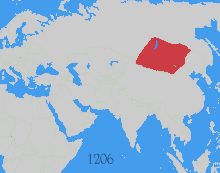History of Iran

Iran is home to one of the world's oldest continuous major civilizations, with historical and urban settlements dating back to 4000 BC.[1] The Medes unified Iran as a nation and empire in 625 BC.[2][2]
The Islamic conquest of Persia (633–656) and the end of the Sassanid Empire was a turning point in Iranian history. Iran had been a monarchy ruled by a shah, or emperor, almost without interruption from 1501 until the 1979 Islamic revolution, when Iran officially became an Islamic Republic on 1 April 1979.[3][4]
Pre-Islamic
[change | change source]
Before Iran was called Iran, and before Iranians lived there, a different group of people, the Elamites, lived there. Their kingdom was called Elam. The Elamites are mentioned in the Bible. Elam was conquered by Iranian peoples, such as the Medes (a type of Iranian), because the Elamites became weak after fighting the Assyrian people (a different people) for too long. The Iranians would then go on to conquer the Assyrians, as well.[5]
The name Iran comes from Aryan and is also mentioned in the ancient book of the Zoroastrians, which was called the Avesta. Iran means "Aryan" in Persian. In the 19th and early 20th century, the name Aryan was used by Europeans to mean all Indo-Europeans.
Around 500 BC, present-day Iran was the center of the Persian Empire. Then, Alexander the Great took the country by fighting and the Arsacid dynasty of Persia later ruled. After them the Sassanian dynasty (224-651) took over.
Islamic Persia
[change | change source]
Other people took Persia by fighting, like the Arabs (7th century), Turks (10th century) and Mongols (13th century). However, Iran has always maintained a distinct culture and continued to survive.
The Safavid dynasty (1502-1736) made Islam and Shi'a the state religion of Iran although Islam was already popular then. The latest kings of Iran were from the Pahlavi dynasty, and ruled from 1925 until 1979, when there was a revolution and Ayatollah Khomeini created an Islamic republic.
In 1951, Mohammed Mossadegh was brought to power after being elected as prime minister by nearly all members of the Majlis (parliament) in Iran. His first act in office was to take control of the oil industry in Iran which had been controlled by Great Britain. Most of Britain's oil was pumped from Iran at the time. This move was seen as a danger to Great Britain's security and empire, so they tried to overthrow the government but failed. After this they convinced the United States through diplomacy that the government of Iran was a communist threat.
The CIA worked in Iran to create riots which led to the removal of Prime Minister Mossadegh. The United States and Great Britain then made the Shah Mohammad Reza Pahlavi King of Iran, again.
Islamic Republic
[change | change source]The Shah ruled in Iran for 38 years. When he left Iran the Iranian government was changed to an Islamic Republic by Islamic Revolution. Soon afterwards, Iranian Students Movement (Tahkim Vahdat), with the backing of the new government took over the U.S. Embassy in Tehran and held most of the diplomats hostage for 444 days. Relations between the two countries have not been good since. For example. The US has imposed various types of economic sanctions against Iran. The US claims the Iran supports terrorist groups against Israel. Iran does not recognize Israel as a state. Iran, along with most Arab countries believe that Israel does not have the right to occupy the land of Palestinians.
Iran has long borders in common with Iraq. (The words "Iran" and "Iraq" are similar only in Latin alphabet. In Arabic and Persian, they are written differently.) Iranians are ethnically not Arabs. Iran defended itself against Iraqi invasion in 1980, a war that lasted eight years. Many Arab and Western countries, including the United States provided weapons (including biological and chemical weapons of mass destruction) and technical support for Iraq's Saddam Hussein.
Now, the West is trying to prevent Iran from mastering nuclear technology, even though Iran is a member of the NPT. They voice their concern claiming that Iran's intention is to develop nuclear weapons. The International Atomic Energy Agency (IAEA) has reported numerous times that there is no evidence that Iran is developing nuclear weapons, however, it also says that it can not say for sure that Iran is not doing so in secret. A CIA report on nuclear activity in Iran, in December 2007 claimed that Iran's secret program to achieve nuclear weapons technology was stopped in 2003, and that since then, it was never restarted. It reports that Iran's ability to build a nuclear weapon will probably not happen soon.
The presidential elections of 13th June 2009 were officially won by the existing president M. Ahmadinejad, but certain people do not believe this is true. There were demonstrations because of these results, and some protesters fought with police forces. Many people who demonstrated thought that the election was a fraud. Officially nine people died during the protests.
References
[change | change source]- ↑ Xinhua, "New evidence: modern civilization began in Iran", 10 Aug 2007, retrieved 1 October 2007
- ↑ 2.0 2.1 https://www.britannica.com/ebc/article-9371723 Encyclopædia Britannica Concise Encyclopedia Article: Media
- ↑ Iran Islamic Republic, Encyclopædia Britannica retrieved 23 January 2008
- ↑ Encyclopædia Britannica 23 January 2008
- ↑ Potts, D.T. (2006). "Elamites and Kassites in the Persian Gulf". Journal of Near Eastern Studies. 65 (2). The University of Chicago Press: 111–119. doi:10.1086/504986. JSTOR 504986. S2CID 162371671.
